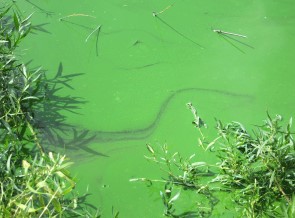By Carolyn Baldwin
Many areas of Kansas have been extremely hot for extended periods this summer. Couple the heat with abundant sunlight and conditions are ripe for the development of blue-green algae in farm ponds. Blue-green algae produce toxins that pose a health risk to livestock that use these ponds for drinking water.
This article discusses the development of blue-green algae, the risks to livestock, and tips for visual identification. A companion article in this eUpdate explains how to send a water sample to be tested and management options for ponds with blue-green algae blooms.
What are blue-green algae?
Blue-green algae include several different species of photosynthetic cyanobacteria that live in water. Cyanobacteria are bacteria capable of photosynthesis. These cyanobacteria can produce toxins that can sicken or kill livestock.
Occasionally, blue-green algae rapidly reproduce and form blooms, or large colonies, that are visible as a scum on the water’s surface. They also may change the water color of a pond. Such blooms of toxic cyanobacteria are often referred to as harmful algal blooms, or HABs. These are typically most severe in stagnant areas where wind disturbance of the water surface is minimal and water temperatures are higher. Floating algal scums may accumulate at the downwind shores of lakes and ponds.
What causes harmful algal blooms?
The causes of harmful algal blooms are not completely understood. They are related to increased nitrogen and phosphorus concentrations in water, but the exact relationships between nutrient concentrations and blooms are complex and difficult to predict.
Although agricultural nutrient runoff is a known risk factor, harmful algal blooms also are found in ponds surrounded by rangeland, where nutrient loading from cropland is rarely an issue. Other environmental factors that may favor the formation of blooms include hot, sunny weather with little wind. Ponds with relatively clear water may be more likely to produce harmful algal blooms due to high sunlight availability, a necessary component for photosynthetic organisms, throughout the water column.
Blue-green algae toxins
The toxins created by blue-green algae species show up as either neurotoxins, or hepatotoxins. Meaning they can damage the nervous system, or affect the liver function of animals. Typically, the first clinical sign noticed in pasture cattle that have consumed neurotoxins are dead cattle. If found early enough, cattle may have muscle tremors, difficulty breathing, seizures, slobbering, and diarrhea. Hepatotoxins can cause an acute death similar to neurotoxins, or lead to delayed issues with liver failure. An example of this would be weight loss and photosensitization and can be recognized by severe sun burns on areas of the body not covered with hair. Since there are several causes of acute death in pasture cattle, contact your local veterinarian for diagnosis. Unfortunately, there are no known antidotes to these cyanotoxins. Understanding what to look for, and avoiding livestock exposure is important.
Most toxins produced during harmful algal blooms are stored within the cyanobacteria until they die. As the cyanobacteria decompose, they release stored toxins into the water. Toxins are not evenly dispersed in a pond. Mycrocystis species, which are generally the most problematic blue-green algae in Kansas, self-regulate their position in the water. This means they are often floating at or near the surface to capture the most sunlight for photosynthesis. When the wind blows in a relatively constant direction, these organisms accumulate on the downwind side of the pond, where toxin concentrations may increase. Other blue-green algae species are less buoyant and may be more widely dispersed in the body of water.
Toxin concentrations can vary dramatically, even at nearby locations in the same pond. Pockets of water that contain lethal quantities of toxins may be within a few feet of areas with low concentrations, making it impossible to determine whether or not a water body is toxic by using a single water sample. Generally, when finding measurable toxin levels, it is prudent to suspect the entire pond is toxic; do not use for livestock or human drinking water. Avoid wading and touching the water as these toxins may irritate skin, eyes, and the respiratory system. Some toxin types may cause the meat of fish to be poisonous. Do not eat fish caught from these ponds.
Identification of blue-green algae
A pond containing a harmful algal bloom may be covered with a scum that looks like bright green paint (Figure 1), but other colors are possible, varying from blue-green to grey, and occasionally red or brown. Some types are filamentous and may form slimy strands when many are clinging to each other. Blue-green algae can be distinguished from duckweed by size, as individual duckweed plants are visible without a microscope. To view images of these plants, visit the website: https://aquaplant.tamu.edu/plant-identification/.

Figure 1. Blue-green algae bloom in a freshwater pond.
Water from a pond with a harmful algal bloom often will have an unpleasant smell. Most livestock will avoid water with this smell, but some dogs are attracted by the smell and are at risk of drinking the water or ingesting scum at the edges of the pond. This behavior may lead to lethal exposures.
Source: ksu.edu